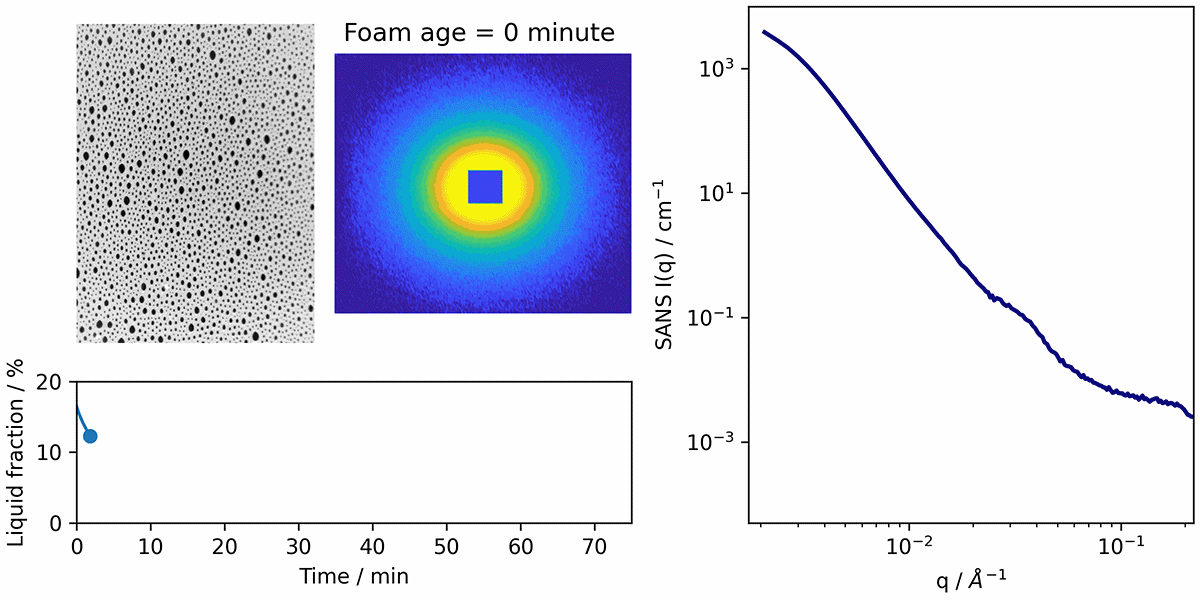Multi-scale structural characterisation of foam: unprecedented detail revealed by a new device at the ILL
30 November 2022
Foams are everywhere, in food, beverages, detergents and cosmetics, as well as industrial processes such as recycling, oil recovery and firefighting. There is thus significant interest in the design of novel foams with properties tailored for specific needs. Foam, however, is an extremely complex material whose structure and aging are influenced by numerous parameters across multiple length scales: from the size of foam bubbles measured at the centimetre scale, to foam channels at the micrometre scale and foam film thicknesses or colloidal aggregates such as surfactant micelles at the nanometre scale. The task is further complicated by the intrinsically unstable nature of foam – properties not only change with time but also according to how the sample was prepared.
As no single technique exists that is capable of acquiring the necessary information simultaneously across all relevant length scales, experiments up until now have been carried out sequentially, with each technique probing a different foam sample. The results obtained, however, are incomparable due to the unique nature of each sample. Furthermore, a global view of the evolution of the foam structure with aging was previously inaccessible, hindering the experimental demonstration of theoretical foam destabilisation mechanisms.
The idea of developing a device capable of probing the same sample of foam with multiple techniques within a single experiment originated with Olivier Diat, deputy director of the Marcoule Institute of Separation Chemistry (ICSM). Isabelle Grillo, instrument scientist at the Institut Laue Langevin (ILL) with responsibility for the D33 diffractometer, was also involved in the genesis of the project until her untimely passing in 2019. Discussions with Leonardo Chiappisi, Scientific Coordinator of the Partnership for Soft Condensed Matter (PSCM), led to the formalization of the project and work started with the arrival of PhD student Julien Lamolinairie at the ILL in September 2020.
The developed device consists of a quartz column – based on the model produced by Teclis Scientific for its FOAMSCAN apparatus – within which the foam sample is prepared. A wide range of information is then collected from the nano to the centimetre scale through the simultaneous use of three techniques: electronic conductivity, macro-photography and small-angle neutron scattering (SANS). Analysis of the data acquired by the device has enabled the first multi-scale characterisation of the structural evolution of foam, significantly improving understanding of the underlying aging processes.
Though each technique has been previously employed to study foam, this new synergistic approach allows the exploration of interconnected parameters. The amount of water in the foam, for example, which can be measured from image data, enables the surface area of the foam films to be extracted from the SANS data. Similarly, the average thickness of foam films, obtained using SANS data, combined with the repulsion between facing foam films, deduced from the curvature of plateau borders in the image data, has allowed the first quantification of pressure inside the foam. Generally, a thin-film pressure balance is used to measure pressure on a single film and despite a similar foam preparation method, a difference of a factor of 10 has been observed between the pressure measured in the foam compared to on a single film, further demonstrating the inaccuracy of combining results obtained from different experimental set-ups.
The unprecedented detail achieved by the new device is made possible by the unique infrastructure available at the ILL. “Small angle neutron scattering involves the scattering out of an incoming neutron beam and the spatial dimension that can be explored by the instrument depends on the divergent angle covered, referred to as the Q-range,” explains Chiappisi. “The ILL’s D33 diffractometer has a uniquely wide Q-range due to that fact that it was designed and equipped with not one but two detectors, one closer and one further from the sample. This set-up enables the full structure of foam to be probed – from hundreds of nanometres to one nanometre – in a single experiment.” The relatively large 15 mm diameter of the neutron beam allows the non-destructive probing of hundreds of bubbles at a time, ensuring that the numbers determined are statistically meaningful. Moreover, the neutrons produced by the ILL – the most intense continuous neutron flux in the world – provide an incomparable temporal resolution that enables the structural evolution of the foam to be closely followed.
Soft matter, like foams, require a number of complementary techniques for sample preparation and characterisation. The ILL, together with the European Synchrotron (ESRF), have developed an extremely well-equipped laboratory to support research in the area. This platform– the Partnership for Soft Condensed Matter (PSCM) – was fundamental for the development of the device. “Extensive preparatory work was carried out at the PSCM to characterise foam using every technique possible. Neutrons are an expensive probe and the PCSM is essential to ensure that they are only used when their contribution is irreplaceable,” explains Chiappisi.
The new device represents an important milestone in the quest to understand foam and opens new perspectives for the field. The scientists involved are committed to ensuring that the full potential of the device is explored and communications have included a recent publication – featured on the front cover of the 46th issue of the Soft Matter journal, in addition to presentations at conferences and workshops, such as the Foams Workshop organised by the ILL in 2022. Two PhD proposals are also currently under evaluation at the ILL that would enable further development in more focused domains. The first aims to explore vegetable-based proteins as a potential replacement for the more commonly used dairy-based extracts for foam stabilisation in the food industry; while the second investigates smart foams employing colloidal particles for foam stabilisation, whose softness can be modulated due to their high sensitivity in response to stimuli such as heat and light.
ILL Instrument and platform:
Re: Soft Matter, 2022, 18, 8733 - 8747 https://doi.org/10.1039/D2SM01252A
Contact: Dr Leonardo Chiappisi, ILL


